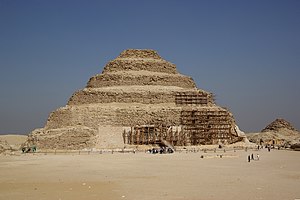Ancient History/Egypt/Old Kingdom
The Old Kingdom began with the rise of the 5th dynasty. The Old Kingdom is marked by the construction of most of Egypt's pyramids, giving the first part of the Old Kingdom the name "tha age of pyramids." The architect Imhotep designed the first pyramid—the Step Pyramid—for Pharaoh Djoser at Saqqara. Larger than any building to have built before it, the Step Pyramid is not a true pyramid, but rather a series of platforms stacked on top of each other, with the smallest level at the top and the largest on the bottom. Djoser's successor Snefru constructed three pyramids at Dashur; the third pyramid—the pink Pyramid—became the first true pyramid to be completed. The greatest pyramids were constructed by the fourth dynasty at Giza. The Giza complex includes the Great Pyramid of Khufu and the Great Sphinx.

These large projects could be constructed due to the mobilization of the whole country to serve the order of the pharaohs. The Old Kingdom ended due to a combination of the rising power of priesthoods and nobility, and a dry period in which the Nile failed to flood annually for several years.